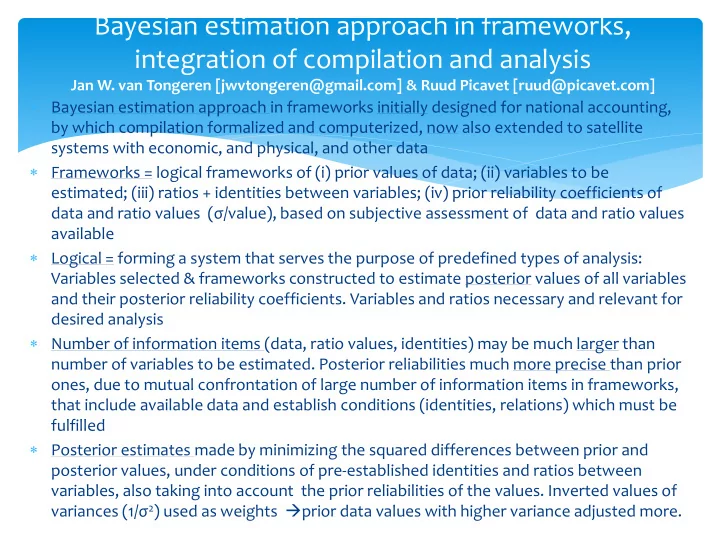

Bayesian estimation approach in frameworks, integration of compilation and analysis Jan W. van Tongeren [jwvtongeren@gmail.com] & Ruud Picavet [ruud@picavet.com] Bayesian estimation approach in frameworks initially designed for national accounting, by which compilation formalized and computerized, now also extended to satellite systems with economic, and physical, and other data Frameworks = logical frameworks of (i) prior values of data; (ii) variables to be estimated; (iii) ratios + identities between variables; (iv) prior reliability coefficients of data and ratio values ( σ /value), based on subjective assessment of data and ratio values available Logical = forming a system that serves the purpose of predefined types of analysis: Variables selected & frameworks constructed to estimate posterior values of all variables and their posterior reliability coefficients. Variables and ratios necessary and relevant for desired analysis Number of information items (data, ratio values, identities) may be much larger than number of variables to be estimated. Posterior reliabilities much more precise than prior ones, due to mutual confrontation of large number of information items in frameworks, that include available data and establish conditions (identities, relations) which must be fulfilled Posterior estimates made by minimizing the squared differences between prior and posterior values, under conditions of pre-established identities and ratios between variables, also taking into account the prior reliabilities of the values. Inverted values of variances (1/σ 2 ) used as weights prior data values with higher variance adjusted more.
Integration of compilation and analysis. Pros and cons of method Prior values of ratios used in compilation can also be used in their posterior format as analytical indicators Thus: Through selection of relevant variables, identities and ratios for logical framework de facto integration of compilation and analysis, which is direct, effective, and efficient Through formalization and computerization and mutual confrontation of more information items: improved accuracy and quicker estimates Through quicker estimates, more over time updates possible, also with fewer data. Approach responds effectively to scarcity of data System not necessarily linked to SNA. Much more flexible and comprehensive: e.g. environmental accounts; socio-economic poverty analysis; economic-demographic National Transfer Accounts. Responds to use of data in all kinds of analysis Assignment of prior reliability coefficients based on subjective assessment of available data and ratio values, but explicitly, not implicitly as in conventional national accounting Capacity of accounting considerable expandable within limits set by software
Assessment illustrated through applications Various applications: Central Banks of Guatemala & Dominican Republic; St. Vincent, Kurdistan. Comparable methods used by Statistics Netherlands Quantitative assessment by comparing (for Guatemala) values and posterior estimates based on comprehensive (2005), and limited (2006) data sets
Assessment and conclusions Differences between Bayesian and NA estimates (Guatemala 2005) very minor, but all estimates improve in accuracy: posterior values of reliability coefficients of variation significantly reduced (e.g. GDP prior 3%, posterior 0.01%) With fewer data available (Guatemala 2006) posterior estimates deviate more (e.g. in 2006, HH consumption posterior value deviates 2.7% and gross fixed capital formation - 5.4%) Bayesian estimation within frameworks generates accurate posterior estimates , even in case of limited data. Estimates within frameworks more reliable, because identity and ratio relationships taken into account Through formalization and computerization more accurate in less time, also with less data. Frameworks defined once, with annual small updates. Framework largely independent of data availability at different points in time. Limited hardware and software needs. Thus requires less training and therefore easier and cheaper to implement. Design of framework is based on a mixture of requirements of analysis and availability of data. The more ratios and identities incorporated in framework, the more precise posterior estimates + the richer posterior analysis Frameworks optimal for link between national economic accounting and satellite accounting (= flexibility and desired analysis) and less data availability Future developments of data (big data) and new types of analysis better supported
Recommend
More recommend